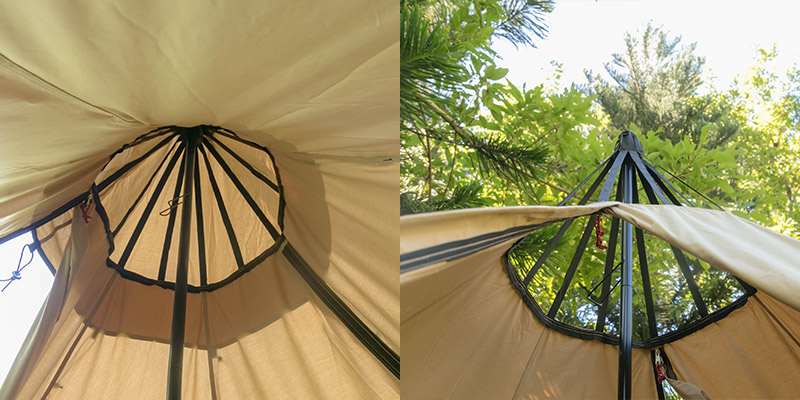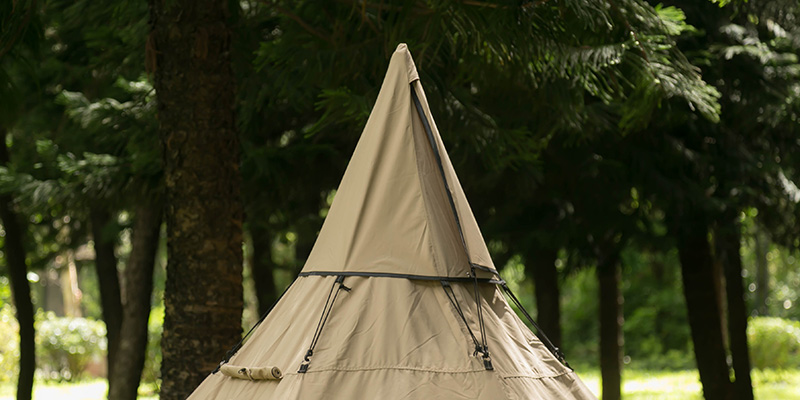http://www.lavvu.com/poles.html
Although the Lavvu can be easily confused with the Native American Tipi - it's not a Tipi! The differences between the two structures are reflected in their respective environments and cultures. Being more centered to the ground, the Lavvu is better able to endure the fierce winds of the Scandinavian tundra, thus a more stable structure. Few structures used by indigenous peoples, with the exception of the Inuit (Eskimo) Igloo, are as stable in strong winds.
https://bushcraftusa.com/forum/threads/laavu-tent.24076/
So I will make a similar Willow tree frame for my Laavu - and it will no longer be a "tipi" with a center pole!! I was concerned about that center pole not being stable enough!! Awesome.
10 Foot (3.3 meter) diameter, Sunforger Lavvu 27 lbs.
$375.00
So it's cool they are making these. I prefer the Silicone treated Poly-canvas instead of the cancer-treated canvas...
So then it's eight poles each 10 feet long - in two sections each.
http://lavvu.com/customerstories.html
"It looks very similar to a teepee," Pesklo said. "But it's structurally different. Its angles are less extreme so it's more stable in high winds. This thing is what dominates the whole coffee shop."
For centuries, lavvus were the standard dwellings of the Sami, the indigenous people of the far northern regions of Norway, Sweden, Finland and Russia.
https://www.mprnews.org/story/2013/02/19/sami-themed-coffee-shop-celebrates-an-arctic-culture
10 Foot (3 meter) diameter, Cotton Duck Lavvu 28 lbs.
$265.00
ITEM 1-1
shipping
* US Domestic $35.00 USD
* Canada $110.00 USD
* Europe and elsewhere - Enquire for shipping cost
Wow a $100 difference for just without the fire-proofing cancer treatment? amazing!!
So the Pomoly tent is 12 pounds... so less than half the weight. Must be a lot smaller!!
Ah so I calculate an 8.5 foot diameter compared to 10 foot diameter for the Laavu...
But there is a much taller and wider angle -
but there's no stove jack - they want you to put the pipe up the center?
One of the major advantages of our lavvus compared to modern tents is that you can have a comfortable fire inside the structure, protected from wind, rain or snow. With proper positioning of your lavvu you can have an open fire inside that is well ventilated from smoke.
An alternative to an open fire is having a lightweight wood burning stove in your lavvu. The stove shown in the above photographs is the Ultra Light I from Four-Dog Stoves of Saint Francis, Minnesota. It is made of titanium, weighing eight pounds and works very well with this lavvu. The stove piping can be put right through the top of the lavvu's smoke hole (works best with five piece piping instead of the included four pieces - ask for an extra one).
Ah yes - Four Dog! Small world...
WAIT - this one is way more like the Pomoly tent!
Wow!!
https://tschum.de/product_info.php?info=p5_tschum-2p-soswa.html
From this youtube camp vid.
So it doesn't have a stove jack! Wild.
Wow $734 US dollars!!
So that's how I can do an external frame for the Pomoly tent. Cool - and not have to use the center pole.
I wonder if this is the SAME tent - made in China?
it is equipped with snow flaps made of 85g PU coated nylon fabric.So that is different....
We recommend a pole length of 180cm.So that's the SAME exact height - I'm suspecting this tent is also made in China...
https://luxe-hiking-gear.com/products/hercules-hot-tent-8p-wood-stove-vent
these tents are cool - literally - too big to heat and the thin fabric doesn't stay warm. Plus more fire hazard and the nylon poles break easily from snow, etc.
This person has a great idea - put a second outer tent around those poles.
Below is the Pomoly Canvas tent pole connectioncomparative advantage is a con term set up to keep Africa from manufacturing and instead only being the victims of primitive accumulation. The trading system is based on monopolies of 4 to 5 corporations per sector - and it's not at all free - especially in regards to Cotton and agriculture. This is what caused the Civil War even - since the Rich Northerners wanted Tariffs against British imports - so manufacturing would go up in the US while the South did not want a Tariff trade war with Britain since it relied on slave labor for profits. But in reality Automation is the number one cause of Job Loss worldwide - even in China.
So the comparative advantage is just back to slave labor. For example over 1 million child slaves grow the Cacao so Cargill and Nestle can get the Chocolate monopoly for the US. https://www.youtube.com/watch?v=7Vfbv6hNeng So the same with the Apparel industry - Nike elite makes billions because the CIA and US military enforced genocide of union activists in Indonesia - which goes on to this day as "Free Market zones" - https://www.youtube.com/watch?v=M5uYCWVfuPQ&t=80s&ab_channel=TeamSweat or I have a whole playlist on this - https://www.youtube.com/playlist?list=PLaxpujmz7Q06t_aqnRcHGBqpYc4iJICqP Zoned for Slavery in Central America and Haiti. Whereas Spain relies on cooperative businesses to maintain better working wages as "comparative advantage." As long as there is a cooperative democratic ownership that does not need a boss as a parasite - then the workers make a better wage.
The standard of the Republican Party around 1870 was “We're the party who opposes slavery and who opposes wage slavery.” Noam ChomskyFor Jefferson, independence presupposed access to one’s own productive property. He anticipated the charge, familiar to Americans until the close of the nineteenth century, the working for hire represented a diminished form of liberty, tantamount to “wage slavery”.
Claudio J. Katz wrote an article in the American Journal of Political Science titled Thomas Jefferson’s Liberal Anticapitalism, Vol. 47, No. 1 (Jan., 2003), pp. 1-17
https://elpidiovaldes.wordpress.com/2017/12/18/wage-slavery-a-quick-history/
Micheal Sandel of Harvard University has written about Lincoln’s conception of freedom and how it relates to wage labor and slavery in a book called “Democracy’s Discontent: America in a search for Public Policy“. The following quotations are taken from a chapter called “Free Labor versus Wage Labor”, Pgs 181-183:
Although he shared the abolitionist’ moral condemnation of slavery, Lincoln did not share their voluntarist conception of freedom. Lincoln’s main argument against the expansion of slavery rested on the free labor ideal, and unlike the abolitionists, he did not equate free labor with wage labor. The superiority of free labor to slave labor did not consist in the fact that free laborers consent to exchange their work for a wage whereas slaves do not consent. The differences was rather that the northern wage laborer could hope one day to escape from his condition, whereas the slave could not. It was not consent that distinguished free labor from slavery, but rather the prospect of independence, the chance to rise to own productive property and to work for oneself. According to Lincoln, it was this feature of the free labor system that the southern critics of wage labor overlooked: “They insist that their slaves are far better off than Northern freemen. What a mistaken view do these men have of Northern laborers! They think that men are always to remain laborers here – but there is no such class. The man who labored for another last year, this year labors for himself. And next year he will hire others to labor for him.
Lincoln did not challenge the notion that those who spend their entire lives as wage laborers are comparable to slaves. He held that both forms of work wrongly subordinate labor to capital. Those who debated “whether it is best that capital shall hire laborers, and thus induce them to work by their own consent, or buy them, and drive them to it without consent,” considered too narrow a range of possibilities. Free labor is labor carried out under conditions of independence from employers and masters alike. Lincoln insisted that, at least in the North, most Americans were independent in this sense: “Men, with their families – wives, sons and daughters – work for themselves, on their farms, in their houses and in their shops, taking the whole product to themselves, and asking no favors of capital on the one hand, nor of hirelings or slaves on the other.
In Lincoln’s hands, the conception of freedom deriving from the artisan republican tradition became the rallying point for the northern cause in the Civil War. In the 1830s and 1840s, labor leaders had invoked this conception in criticizing northern society; wage labor, they feared, was supplanting free labor. In the late 1850s, Lincoln and the Republicans invoked the same conception in defending northern society; the superiority of the North to the slave holding South consisted in the independence the free labor system made possible.
The Union victory in the Civil War put to rest the threat of free labor posed by the slave power, only to revive and intensify the threat posed by the wage system and industrial capitalism. Lincoln had led the North to war in the name of free labor and the small, independent producer, but the war itself accelerated the growth of capitalist enterprise and factory production.
In 1869 the New York Times reported on the decline of the free labor system and the advance of wage labor. Small workshops had become “far less common than they were before the war,” and that “the small manufactures thus swallowed up have become workmen [for] wages in the greater establishments, whose larger purses, labor-saving machines, etc., refused to allow the small manufacturers a separate existence.” The article criticized the trend it described in terms reminiscent of the labor movement of the 1830s and 1840s. The fall of the independent mechanic to wage earner status amounted to “a system of slavery as absolute if not as degrading as that which lately prevailed in the South“.The 1870 census, the first to record detailed information about Americans’ occupations, confirmed what many workers already knew. Not withstanding a free labor ideology that tied liberty to ownership of productive property, American had become a nation of employees.
Experience demonstrates that there may be a slavery of wages only a little less galling and crushing in its effects than chattel slavery, and that this slavery of wages must go down with the other.
Frederick Douglas
They who work in the mills ought to own them.”
The shoemakers signed a “declaration of independence” [The Awl, 1844]
The Industrial Worker, 1840-1860: The Reaction of American Industrial Society to the Advance of the Industrial Revolution. Published in 1924 by Canadian-born historian Norman Ware, this book goes into meticulous detail about the conditions of the labor classes following the rise of industrialism in the mid-19th century. Many of these observations and conclusions are drawn from workers’ writings in the popular labor newspapers of the time, including Voice of Industry, Working Man’s Advocate, and The Awl.
Plato was worse than we think. Michael E. Hudson, the economics professor, cites Archytas promoting music theory to justify the social "harmony" of wealth inequality. How and Why? Hudson started out studying music theory and then switched to economics. So Math Professor Luigi Borzacchini has researched how Western science is secretly founded from music theory - a cover up Borzacchini calls "shocking" and "really astonishing" and a "deep pre-established disharmony" as the "guiding evoltive principle" of science.
So Plato promoted logarithmic mathematics as "Alogon" music theory - meaning the Tyrant equals the Tritone and the people as citizens each 9/8 major 2nd music interval that must be compromised for the Good of the State. Musicology professor Erno Lendvai (The Pythagorean Plato) goes into this (and promotes it himself). So as Physics Professor Albert Bartlett has detailed - the problems of today are all due to misunderstanding the Exponential Function (the inverse of logarithms). Bartlett gave the SAME lecture over 1000 times - about how economic growth was a lie and would lead to the destruction of life on Earth.
http://arctic-news.blogspot.com details how that destruction has now been locked in due to positive feedback cycles of Mother Nature - the East Siberian Arctic Shelf methane bomb for one and the Aerosol Masking Effect for another - each contributing 1 Degree Celsius increase in warming on immediate terms - in the near future.
So to go back to Plato - the book "The Racial Contract" details how Plato promoted "natural law" as eugenics - based on the above wrong music theory (we're all brainwashed to think that music is to be based on equal-tempered tuning as "harmony"). And so when Islam spread Platonic philosophy into Spain in the 9th century - Professor David F. Noble's book "The Religion of Technology" goes into the details of what happened and its consequences - his follow up book "Myth of the Promised Land" gives more details. Noble refused to even use email - much less not watching television. haha.
They ought to be so constituted as to protect the minority of the opulent against the majority.
James Madison, "father" of the US Constitution
Sewing a good tent is not an easy thing.You need a suitable machine, hand tool and knowledge of how to make different types
of seams and details. If you feel up to the requirements, you are welcome to sew your own tents forprivate use according to our pattern.

https://tschum.de/shop_content.php?coID=3210125
Wow - so looks like China took up Germany on that offer!
Vid of Pomoly-Tschum tent haha








No comments:
Post a Comment